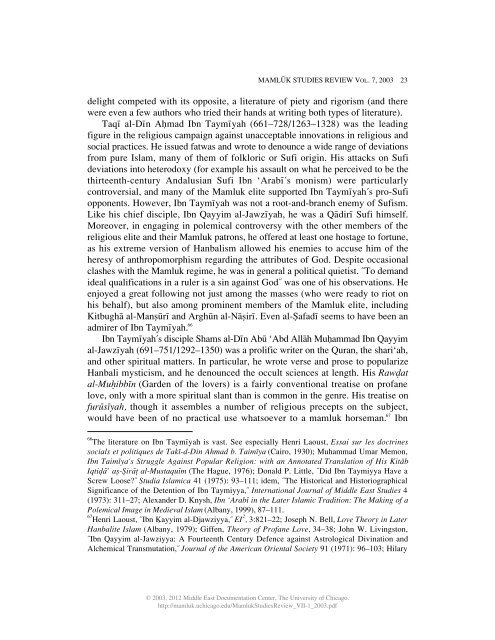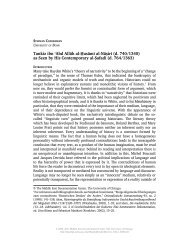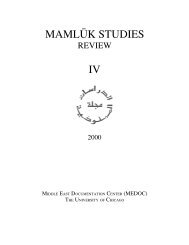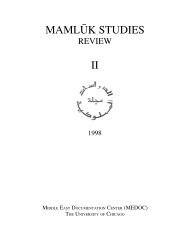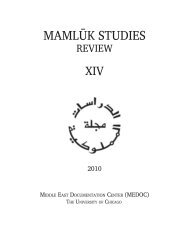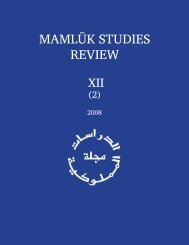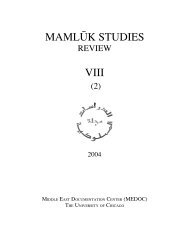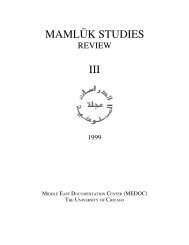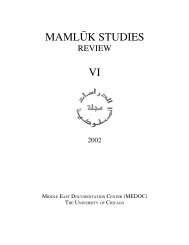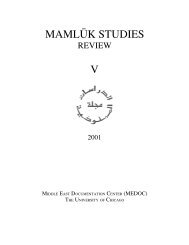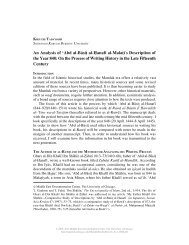Vol. VII, no. 1 (2003) - Mamluk Studies Review - University of Chicago
Vol. VII, no. 1 (2003) - Mamluk Studies Review - University of Chicago
Vol. VII, no. 1 (2003) - Mamluk Studies Review - University of Chicago
Create successful ePaper yourself
Turn your PDF publications into a flip-book with our unique Google optimized e-Paper software.
MAMLU±K STUDIES REVIEW VOL. 7, <strong>2003</strong> 23<br />
delight competed with its opposite, a literature <strong>of</strong> piety and rigorism (and there<br />
were even a few authors who tried their hands at writing both types <strong>of</strong> literature).<br />
Taq| al-D|n Ah˝mad Ibn Taym|yah (661–728/1263–1328) was the leading<br />
figure in the religious campaign against unacceptable in<strong>no</strong>vations in religious and<br />
social practices. He issued fatwas and wrote to de<strong>no</strong>unce a wide range <strong>of</strong> deviations<br />
from pure Islam, many <strong>of</strong> them <strong>of</strong> folkloric or Sufi origin. His attacks on Sufi<br />
deviations into heterodoxy (for example his assault on what he perceived to be the<br />
thirteenth-century Andalusian Sufi Ibn ‘Arab|'s monism) were particularly<br />
controversial, and many <strong>of</strong> the <strong>Mamluk</strong> elite supported Ibn Taym|yah's pro-Sufi<br />
opponents. However, Ibn Taym|yah was <strong>no</strong>t a root-and-branch enemy <strong>of</strong> Sufism.<br />
Like his chief disciple, Ibn Qayyim al-Jawz|yah, he was a Qa≠dir| Sufi himself.<br />
Moreover, in engaging in polemical controversy with the other members <strong>of</strong> the<br />
religious elite and their <strong>Mamluk</strong> patrons, he <strong>of</strong>fered at least one hostage to fortune,<br />
as his extreme version <strong>of</strong> Hanbalism allowed his enemies to accuse him <strong>of</strong> the<br />
heresy <strong>of</strong> anthropomorphism regarding the attributes <strong>of</strong> God. Despite occasional<br />
clashes with the <strong>Mamluk</strong> regime, he was in general a political quietist. "To demand<br />
ideal qualifications in a ruler is a sin against God" was one <strong>of</strong> his observations. He<br />
enjoyed a great following <strong>no</strong>t just among the masses (who were ready to riot on<br />
his behalf), but also among prominent members <strong>of</strong> the <strong>Mamluk</strong> elite, including<br />
Kitbugha≠ al-Mans˝u≠r| and Arghu≠n al-Na≠s˝ir|. Even al-S˛afad| seems to have been an<br />
admirer <strong>of</strong> Ibn Taym|yah. 66<br />
Ibn Taym|yah's disciple Shams al-D|n Abu≠ ‘Abd Alla≠h Muh˝ammad Ibn Qayyim<br />
al-Jawz|yah (691–751/1292–1350) was a prolific writer on the Quran, the shari‘ah,<br />
and other spiritual matters. In particular, he wrote verse and prose to popularize<br />
Hanbali mysticism, and he de<strong>no</strong>unced the occult sciences at length. His Rawd˝at<br />
al-Muh˝ibb|n (Garden <strong>of</strong> the lovers) is a fairly conventional treatise on pr<strong>of</strong>ane<br />
love, only with a more spiritual slant than is common in the genre. His treatise on<br />
furu≠s|yah, though it assembles a number <strong>of</strong> religious precepts on the subject,<br />
would have been <strong>of</strong> <strong>no</strong> practical use whatsoever to a mamluk horseman. 67 Ibn<br />
66 The literature on Ibn Taym|yah is vast. See especially Henri Laoust, Essai sur les doctrines<br />
socials et politiques de Tak|-d-Din Ahmad b. Taim|ya (Cairo, 1930); Muhammad Umar Memon,<br />
Ibn Taim|ya's Struggle Against Popular Religion: with an An<strong>no</strong>tated Translation <strong>of</strong> His Kita≠b<br />
Iqtid˝a≠’ as˝-S˝ira≠t¸ al-Mustaqu|m (The Hague, 1976); Donald P. Little, "Did Ibn Taymiyya Have a<br />
Screw Loose?" Studia Islamica 41 (1975): 93–111; idem, "The Historical and Historiographical<br />
Significance <strong>of</strong> the Detention <strong>of</strong> Ibn Taymiyya," International Journal <strong>of</strong> Middle East <strong>Studies</strong> 4<br />
(1973): 311–27; Alexander D. Knysh, Ibn ‘Arab| in the Later Islamic Tradition: The Making <strong>of</strong> a<br />
Polemical Image in Medieval Islam (Albany, 1999), 87–111.<br />
67 Henri Laoust, "Ibn K˛ayyim al-Djawziyya," EI 2 , 3:821–22; Joseph N. Bell, Love Theory in Later<br />
Hanbalite Islam (Albany, 1979); Giffen, Theory <strong>of</strong> Pr<strong>of</strong>ane Love, 34–38; John W. Livingston,<br />
"Ibn Qayyim al-Jawziyya: A Fourteenth Century Defence against Astrological Divination and<br />
Alchemical Transmutation," Journal <strong>of</strong> the American Oriental Society 91 (1971): 96–103; Hilary<br />
© <strong>2003</strong>, 2012 Middle East Documentation Center, The <strong>University</strong> <strong>of</strong> <strong>Chicago</strong>.<br />
http://mamluk.uchicago.edu/<strong>Mamluk</strong><strong>Studies</strong><strong>Review</strong>_<strong>VII</strong>-1_<strong>2003</strong>.pdf


